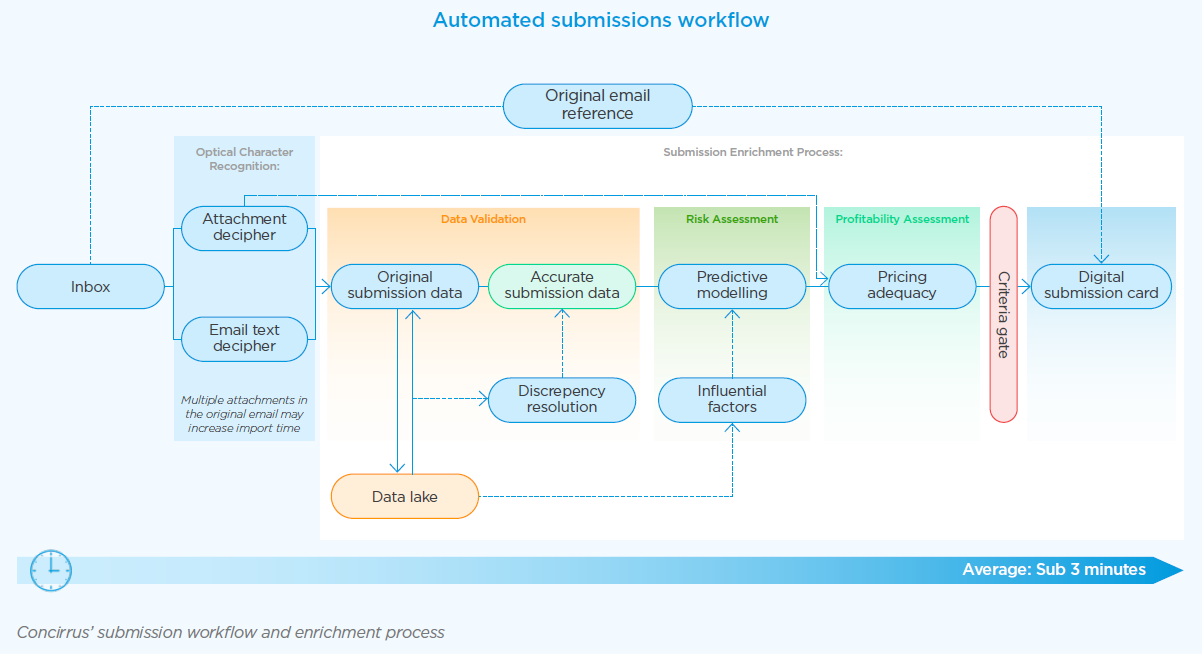As technology makes operations more efficient, and risk analysis more advanced, the time taken for underwriters to triage accounts decreases. Understanding the quality of written business, its source, and why business is not taken up or lost, helps Head Underwriters adjust tactics to meet long-term objectives. The way technology improves placement, team capacity, decision making and strategy have been consolidated here.
A measure of how effective a new process is can be done through comparison. Account managers within Concirrus are typically ex-underwriters/brokers. Their experience has been leveraged to help compare a traditional process to the results of a capability test.
How fast can a submission be processed?
Concirrus’ submissions workflow is displayed below. You can see that data is read, imported, validated, scored, filtered, formatted, and presented in a digital environment automatically. The average time for a submission to move though this workflow is 3 minutes. For larger submissions, there’s more data to process, which can increase the time taken to process.

Two specific tests have been conducted to measure the processing speed of large submissions. The first assessed large submission speed when one submission is received after another. The second was a stress test, where the system received all submissions at the same time.
Experience matched to test results
Aligning experience with test results, it’s clear that there is a significant difference between automation and traditional working methods.

*Manual timings based on perception. Cargo perspective reflects equivalent processing of storage locations.
Comparing automated to existing Cargo and Hull practice
Cargo
Submissions are not currently administered by a single individual as multiple skillsets are required. This means inter-departmental dependencies and priorities come into play.
“For a Cargo submission, an underwriter could take around 20 minutes to carry out an initial evaluation of the risk. It’s important to realise that’s just the start of the process. It may take a further 30 minutes for an Underwriting assistant, operations team, or third-party data processing vendor to enter this risk into an admin system. Exposure teams would then take at least 30 minutes to consider an equivalent volume of storage locations. That’s approx. 1 hour 20 minutes without a compliance check. For each significant cargo risk, it may take around 2 hours to determine the extent to which risk matches appetite.” – Ryan Matthews, Director of Customer Success at Concirrus and ex-Cargo underwriter.
“A tool that can automate the manual aspects of risk import and evaluation makes the heavy collective effort of multiple departments far more efficient. If an Underwriter can qualify the risk earlier in the risk assessment process, faster, the entire operation becomes far more effective. More business can be won with less resource, improving the capacity of the total business.”
Hull
“When I was an underwriter, I’d typically look at submissions depending on whether it is, or isn’t, new business. If it’s new business, I’d ask why I’m seeing the risk, consider if it falls within appetite, and review accordingly. New business requires new analysis, which involves additional teams. If it’s business I’d written previously, it would require targeted analysis to identify any material change made during the policy period.” – Dermot O’Flynn, Strategic Client Manager at Concirrus and ex-Hull underwriter. “To put a rough time on a submission is difficult as there’s multiple considerations. Typically, it takes around 15 minutes to import a digital schedule if the system being used is streamlined. Such large risks would usually come in via digital format, such as a spreadsheet. You’re typically looking at another 20 minutes to review the results of a pricing model and loss records. If there’s the need for me to flag a concern with compliance, that can add time. It would typically take around an hour to pass through the traditional process.”
“The comparison between a traditional and automated workflow is significant considering you have data validation, risk scoring, and pricing included. It means underwriters can reduce the time spent on analysis and focus on risk selection. With fast and informed decisions, an insurer can reduce broker response times, resulting in the receipt of more risk for consideration. This is significant for today’s market, as risk is often sent to multiple underwriters. Slow broker response times can lead to opportunity costs if the underwriter misses the opportunity to quote lead terms or their desired line size, which can be expensive long-term”
It may be fast, but is it accurate?
“Recent trials with live clients show the accuracy of our data import process to be 97%. Alongside automated ingestion, the actual copy of the email is included with each submission, as well as an accuracy metric for key fields. Underwriters can always validate data as and when they choose.” – Martin Lukey, Submissions Product Manager at Concirrus.
“Validation extends beyond data entry. All data imported is checked for inaccuracies by leveraging a comprehensive and highly curated data lake that underpins the behavioural analysis, and pricing capabilities, of insurers in the market today. This process doesn’t just make sure the information matches the email, it ensures the information in the email is correct, corrects minor discrepancies, or tells you when something is a clear error. These checks maintain the integrity of the data entering admin systems, reducing human error and unnecessary cost associated with incorrect records.”
Find out more about how Concirrus validates data, such as missing IMO’s, and helps business selection through pricing adequacy. Or talk to a member of our team directly.

Powering the future of insurance
If you want to book a 1-1 meeting with us then let us know by clicking the link below.
Book a meeting
